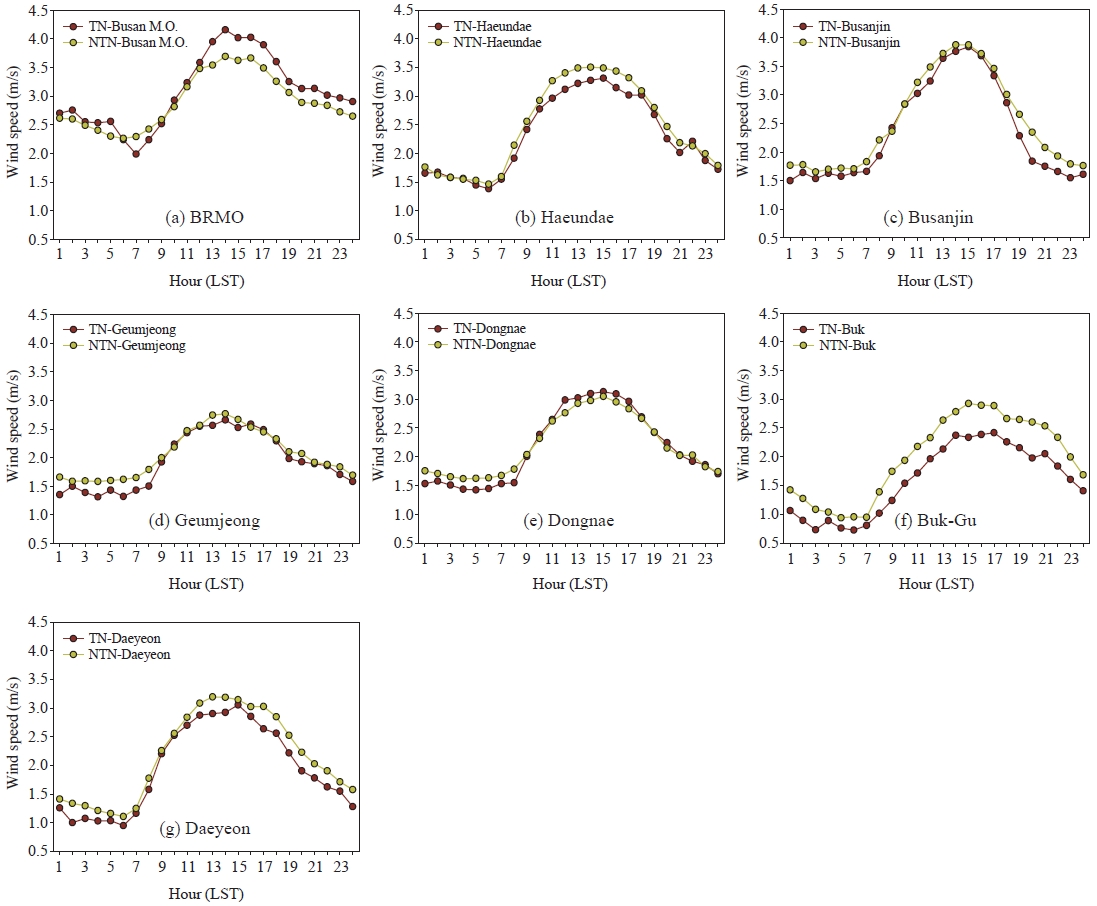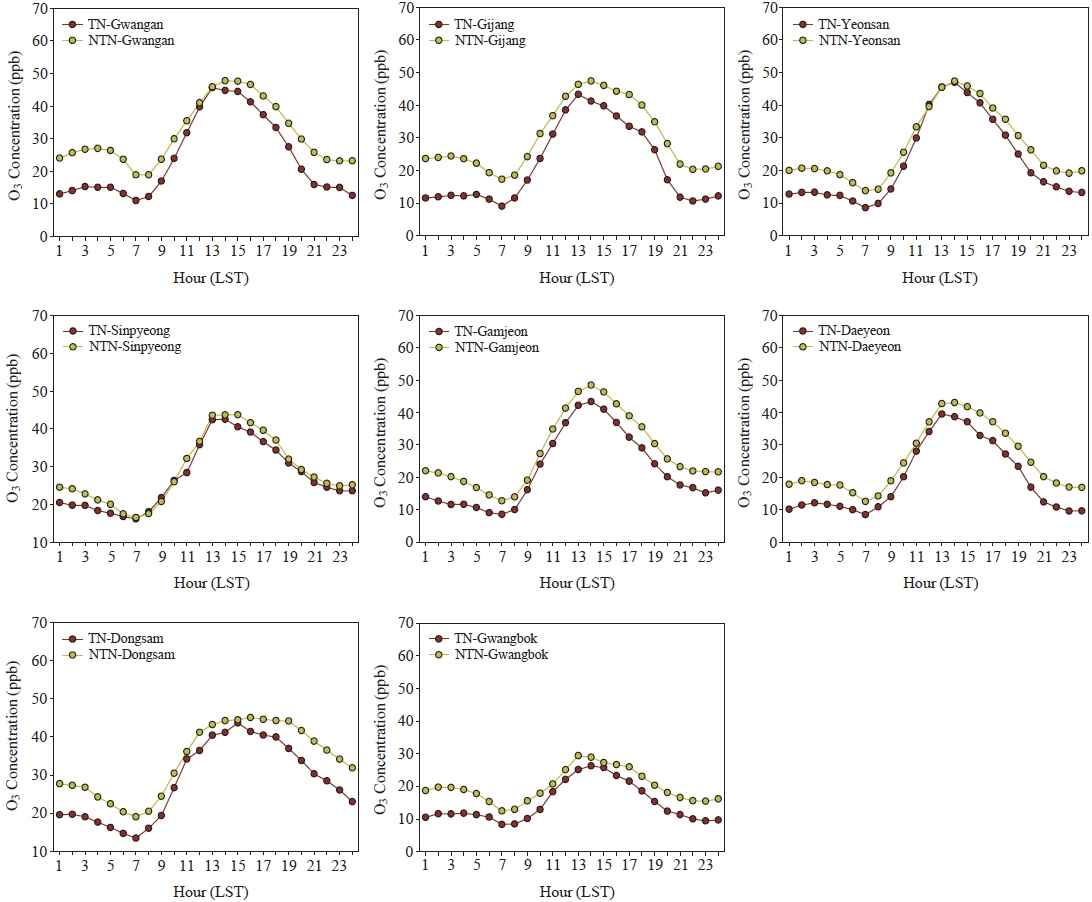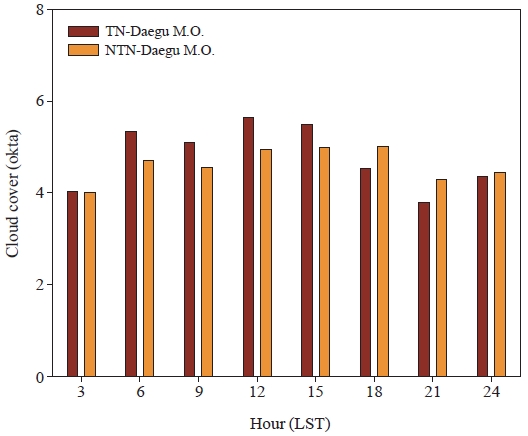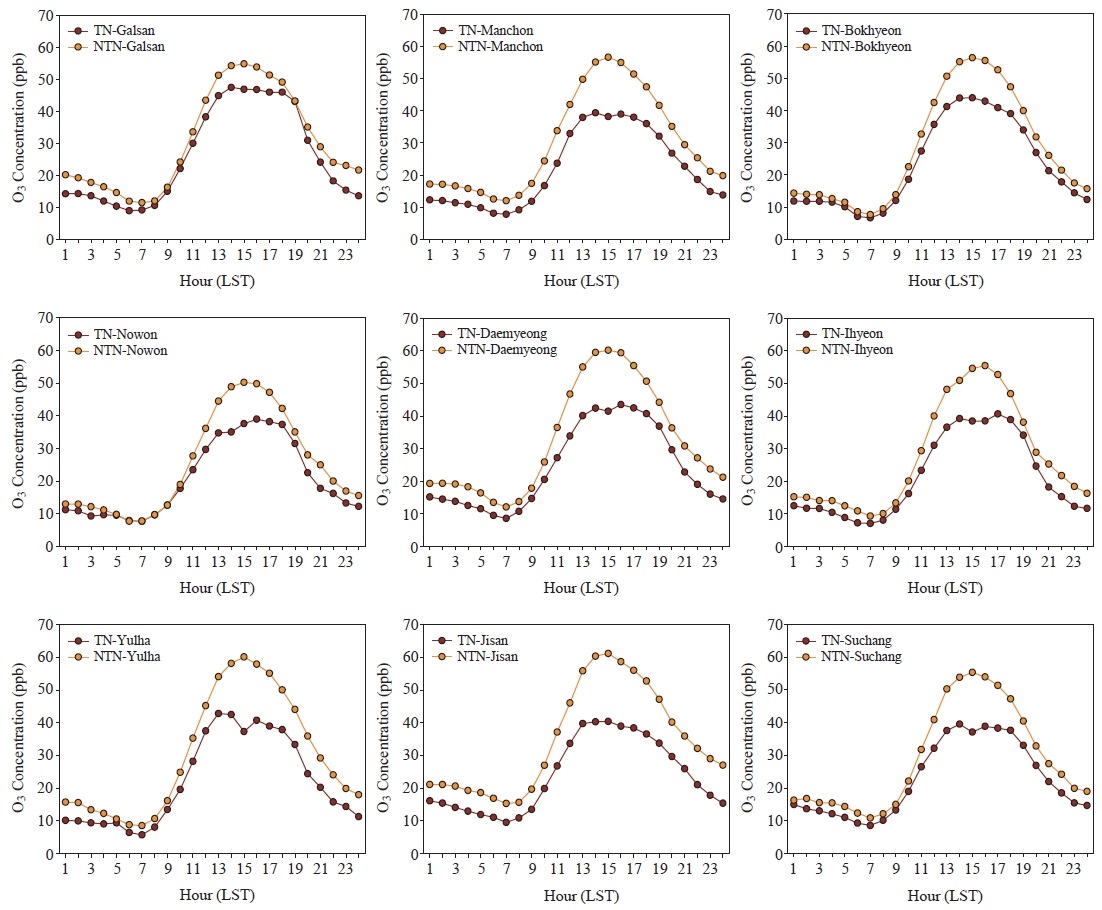
Effect of an Urban Thermal Environment on the Air Quality in Two Cities
Abstract
In this study, the effects of an urban thermal environment on air quality were investigated using hourly surface weather observation data and air quality data over six summers from 2000 to 2005 in two cities on the Korean Peninsula. One, the city of Daegu, is representative of basin topography and the other, the city of Busan, represents a coastal area. It is known that the characteristics of an urban thermal environment are represented as an “urban heat island”. Here, we focus on the nighttime urban thermal environment, which is called a “tropical night”, during the summer. On tropical nights in Busan, the temperature and cloud cover levels were higher than on non-tropical nights. Wind speed did not appear to make a difference even on a tropical night. However, the frequency of southwestern winds from the sea was higher during tropical nights. The prevailing southwest winds in all areas meant an inflow of air from the sea. So at most of the air quality stations, the ozone concentration during tropical nights was lower than during non-tropical nights. In Daegu, the tropical nights had higher temperatures and cloud covers. Despite these higher temperatures, the ozone concentration during the tropical nights was lower than that on non-tropical nights at most of the air quality stations. This feature was caused by low irradiance, which in turn caused an increased cloud cover. Wind speed was stronger during the tropical nights and dispersed the air pollutants. These meteorological characteristics of the tropical nights reduced ozone concentrations in the Daegu Basin.
Keywords:
Tropical night, Ozone concentration, Urban thermal environment1. INTRODUCTION
In recent years, urban thermal environments have worsened. On days when the air temperature exceeds 30°C, sultry nights and heat strokes increase, due to changes in terrestrial cover and higher anthropogenic heat emissions from urbanization (MEJ, 2000). Extreme temperatures threaten people’s well-being in a surprising number of ways. Each summer in the United States, approximately 175 to 200 deaths are attributed to heat waves and most of these deaths occur in cities (Steave and Jone, 2003). Monton et al. (2001) showed a significant increase in hot days and warm nights and a decrease in cool days and cold nights across Southeast Asia and the South Pacific region since 1961.
In Korea, the overall temperature increase is not as serious as above, but because of rapid urbanization and industrialization warm nights have significantly increased. A warm summer night is a “tropical night” defined as when the minimum air temperature exceeds 25°C. Kwon (2002) found that the number of tropical nights in Korea has increased to a ratio of 5 days/100 years.
Cities growing due to urbanization and human activities are large sources of atmospheric pollutants. Consequently, interest has increased in urban air quality and numerous related studies have been performed (Cros et al., 2004; Martilli et al., 2003; Menut, 2003; Kambezidis et al., 1995). These studies documented atmospheric pollution in urban areas or explained regional atmospheric pollution by the presence of an urban heat island.
Dr. Crutzen suggests that anthropogenic heat flux substantially influences air quality, which is aggravated by increasing demands on air conditioning in often ill-ventilated cities, leading to further heating and the release of CO2 (carbon dioxide) (Crutzen, 2004).
Similarly, tropical nights have several effects on urban air quality. The power needed to compensate for tropical nights requires significant additional generating capacity, which contributes to urban air pollution. Elevated temperatures associated with tropical nights accelerate the formation of smog. However, the urban tropical nights also raise the mixing height under which air is constantly mixed due to free convection and turbulence above a city’s surfaces. This increase in mixing height reduces smog by dispersing air pollutants into a larger volume of air.
The primary purpose of this study is to examine how the two contradictory effects influence air quality.
The objectives of this study are to understand the meteorological characteristics of tropical nights and to investigate the effect of urban thermal environment on air quality. These are achieved by analyzing observation data such as temperature, wind speed, wind direction, relative humidity, cloud cover, and ozone concentration on tropical nights compared with this data on non-tropical nights.
2. DATA AND METHODS
Data used in this study was obtained from the Korea Meteorological Administration (KMA) and consists of surface observations at Busan, Daegu, and nearby surface observations at Gumi and Miryang (Fig. 1). The air quality data was obtained from National institute of Environment Research (NIER). A tropical night is defined as when air temperature exceeds 25°C. This means the daily minimum temperature is higher than 25°C. We used a relative approach for a tropical night definition. In the study area, there are many AWS stations. So, for the analysis of air quality, the tropical nights in Busan and Daegu are defined as occurring at more than two AWS sites in study area.

Weather stations and topography of Busan (a) and Daegu (b). The black circles indicate AWS. Air quality sites are marked by triangles.
To investigate the meteorological characteristics of tropical night, we analyzed hourly surface weather observations and air quality data with no rain for 6 summers in Busan and Daegu metropolitan city. We analyzed hourly temperature, wind speed, wind direction, relative humidity, and cloud cover and compared those to non-tropical nights.
Busan, the second largest city in Korea, is located in the southeastern part of the Korean Peninsula, and has a population of about 4 million people. Daegu is located inland, southeast of the Korean Peninsula, surrounded by high mountains in the northeast and south, and is representative of basin topography. Daegu has long been notorious for its hot summers.
3. RESULTS
3. 1 Tropical Nights
Table 1 shows the number of tropical nights from 2000 to 2005. In 2002 and 2003, the frequency of tropical nights was low because those years were influenced by El Niño. In Korea, during El Niño, there is a slight tendency toward cooler summers and warmer winters (Cha and Oh, 1992). Tropical nights occurred an average of 12 days and 8 days yearly in Busan and Daegu, respectively.
3. 2 Busan
The summer atmospheric conditions in Busan starting from June are influenced by the North Pacific high-pressure system, with prevailing southwesterly wind systems. In general, though the diurnal summer temperature range is large, the drop in temperature from the daily maximum to the nightly minimum still leaves hot nights .
Fig. 2 shows diurnal variations of temperatures during tropical nights in comparison with non-tropical nights. When tropical nights occurred, the temperature was higher than those of non-tropical nights at every observation station. Fig. 2(h) shows the time series of temperatures in Miryang for the same period that tropical nights occurred in Busan. Under the same synoptic conditions, tropical nights did not occur in Miryang. Thus, tropical nights are a characteristic of urban thermal environments. Temperature and cloud cover showed that tropical nights occurred on relatively hot and clear days. In general, clouds have a large impact on the solar and terrestrial energy gains near the surface by reducing the amount of solar radiation reaching the surface and causeing daytime cooling. The thicker the cloud, the more pronounced the cooling. However, clouds also have a warming effect, because they emit long wave radiation toward the surface. This warming effect can be very pronounced at night, keeping minimum temperatures higher than in clear-sky regions (Steven and John, 2003) The low cloud cover during the tropical night means that there was something to set off radiative cooling at night. The maximum intensity of the urban heat island recorded at night.
There was no difference in wind speeds even during tropical nights (Fig. 4). In the stations at the Busan Regional Meteorological Office (BRMO) and Buk-Gu, wind speeds showed little differences (<0.5 m/s). But wind direction changed during tropical nights. Fig. 5 shows that the wind rose during tropical nights in comparison with non-tropical nights. The results of analyzing wind rose are a southwestern wind that is considered a sea breeze blowing more during tropical night and except Gemjung station and Buk-Gu stations. In summer, the prevailing synoptic winds over Busan are southwesterlies. Under weak synoptic conditions, well-developed land-sea breezes are a prominent feature. In the case of tropical nights, land breezes at night are weaker than during a non-tropical night because the land did not cool off until late at night. The patterns of wind direction at the Gemjung and Buk-Gu stations are influenced by topography. The Buk-Gu station is affected by the Nakdong River. The Gemjung station is located on the Guemjung Mountain. Thus, these two stations are influenced by local topography.
Fig. 6(a) shows relative humidity at BRMO. During tropical nights, the weather is more humid. Measured radiance value shows that tropical nights followed a clear day (Fig. 6(b)). As a result, tropical nights happened when the weather was clearer (the evidence of clouds and radiation in comparison with non-tropical nights). These conditions created a high ozone concentration.
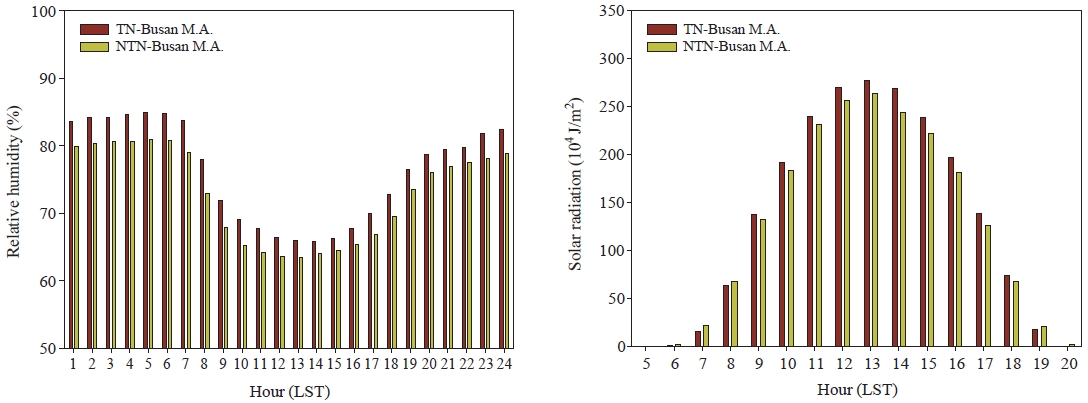
Comparison of relative humidity (a) and solar radiation (b) at BMO during tropical nights and non-tropical nights.
The tropical night effect is evident mainly in metropolitan areas where the buildings and paved surfaces tend to emit radiation at night. The result is an increase in ambient air temperature in urban centers relative to the surrounding areas. To investigate the effects of tropical night on air quality, we focused on ozone, which is a major environmental concern because of its adverse impacts on human health, including its effects on agricultural crops. Emissions of nitrogen oxides (NOx) and volatile organic compunds (VOCs) from both manmade and natural sources react in the presence of sunlight to form ground-level ozone. Elevated ozone concentrations are associated with warm temperatures. Emissions of biogenic hydrocarbons increase with temperature, as do evaporative emissions of anthropogenic volatile organic compounds. These increases in emissions can be associated with increased ozone. Meteorologically, high temperatures are frequently associated with high pressure stagnant conditions that lead to suppressed vertical mixing and elevated ozone levels.
Detailed studies of high ozone concentrations in Busan have found that increased atmospheric stability in low altitudes due to sea breeze penetration to the city in early afternoon restricted the vertical mixing of photochemically produced ozone and contributed to ozone pollution near the surface. In addition, ozone and its precursors can be transported to the sea with a land breeze, accumulated on the sea, and returned to the land in the daytime with the sea breeze (Oh, 2003).
As mentioned, the meteorological characteristics of a tropical night can create a high ozone concentration. Fig. 7 shows an averaged time series of ozone concentration during tropical nights in comparison with nontropical nights. At most of the air quality stations, the ozone concentration during tropical nights was lower than that of non-tropical nights. In the nighttime, the difference was large between the ozone concentration during tropical nights and during non-tropical nights. This means that meteorological characteristics of tropical nights create low ozone levels. Wind direction is partly responsible. The prevailing southwesterly wind in all areas means an inflow of clean air from the sea. In addition, high temperatures during tropical nights can increase mixing height and disperse pollutants higher.
In summary, a low level of ozone concentration during tropical nights is caused by changing wind direction. In other words, inflows from the sea result in good ventilation in urban areas. Therefore, the ozone concentrations are lower despite the higher temperatures.
3. 3 Daegu
Deagu had an average of eight tropical nights a year. Under the same synoptic weather conditions, the daily minimum temperature of Daegu was higher than in nearby Gumi. Fig. 8 shows hourly averaged temperatures during tropical nights in comparison with nontropical nights. The temperatures in Gumi were on the same days as tropical nights in Daegu. The minimum temperature in Gumi was lower than 25°C, meaning that the tropical nights of Daegu were the result of an urban thermal environment.
Fig. 9 shows the hourly averaged wind speed in downtown Daegu. Unlike Busan, the wind speed here is a special feature of tropical nights. Wind speed is about 2 m/s on average during tropical nights and about 1 m/s during non-tropical nights both more apparent at the Seo-Gu station. Wind speed is faster than for non-tropical nights and disperses air pollutants. The prevailing wind system of Daegu is easterly in summer. On tropical nights the wind direction changes to westerly (Fig. 10).
Cloud cover from 3 AM to 9 PM during tropical nights was higher than on non-tropical nights (Fig. 11). This is very interesting because we suggest that this cloud cover can be made of ascending urban air. This needs a more complicated analysis of cloud depth and classification for clouds.
Relative humidity is higher than on non-tropical nights (Fig. 12(a)). This results from the change of wind direction. When tropical nights occurred, the wind direction changed from easterly to westerly. Daegu is surrounded by mountains, and DMO station is affected by this during tropical nights.

Comparison of relative humidity (a) and solar radiation (b) at DMO during tropical nights and non-tropical nights.
In Daegu, tropical nights had higher temperatures and relatively higher cloud cover. Clouds have a large impact on the solar and terrestrial energy gains near the surface by reducing the amount of solar radiation reaching the surface (Fig. 12(b)), and they have a warming effect, because they emit long wave radiation toward the surface. This warming effect can be very pronounced at night, keeping minimum temperatures higher than in clear-sky regions.
Fig. 13 shows an averaged time series of ozone concentration during tropical nights in comparison with non-tropical nights. At most of the air quality stations, ozone concentration during tropical nights is lower than that of non-tropical nights. This feature is caused by low irradiance. In other words, the condition of tropical night is blocked to produce ozone photochemically. Wind speed is strengthened during tropical nights and disperses air pollutants. These meteorological characteristics of tropical nights can reduce ozone concentration in the Daegu Basin.
4. CONCLUSIONS
Heat pollution and air quality in cities are becoming serious issues due to urbanization. This study analyzed the meteorological characteristics during tropical nights characterized by the currently increasing city’ thermal environments and the effect of tropical nights on city air quality.
Tropical nights are defined as a minimum temperature of more than 25°C at night measured at two weather stations in a certain area in the study. Characteristics of meteorological factors during tropical nights are compared and analyzed against to characteristics of normal days. In Busan, tropical nights occurred during days with a little cloud cover and sufficient radiance and when the wind direction changed. In Daegu, the wind direction changed and tropical nights occurred during days of heavy cloud cover and weak radiance more frequently than during other days.
The ozone concentration of tropical nights is compared to that of normal days in order to understand the effect of tropical nights on air quality. When the tropical nights occurred, the total ozone concentration decreased due to the high-level mixing height arising from thermal factors of tropical nights in Busan. However, in case of Daegu, the horizontal transportation due to an increase in wind speed during tropical nights made the ozone concentration lower under the condition that increasing cloud cover and weak radiance prohibit the generation of ozone photochemically.
In this study, we analyzed the relations between the urban thermal environment and urban air quality in two local areas using the surface observation data. It is expected that if we applied these results to a numerical simulation to evaluate the effect of urban thermal environment on air quality quantitatively, more complicated mechanisms between the urban thermal environment and urban air quality in local areas could be better understood.
Acknowledgments
This work was supported by the National Research Foundation of Korea Grant funded by the Korean Government [NRF-2009-351-C00070].
REFERENCES
- Cha, E.-J., Oh, S.-N., (1992), Impact of El Nino and La Nina on climate, Atmosphere, 9(2), p6-9, (in Korean).
-
Cros, B., Durand, P., Frejafon, E., Kottmeier, C., Perros, P., Peuch, V., Ponche, J., Robin, D., Sad, F., Toupance, G., Wortham, H., (2004), The ESCOMPTE program: an overview, Atmospheric Research, 69(3-4), p241-279.
[https://doi.org/10.1016/j.atmosres.2003.05.001]

- Crutzen, P., (2004), New directions: the growing urban heat and pollution ‘island’ effects-impact on chemistry and climate, Atmospheric Environment, 38, p3539-3540.
-
Kambezidis, H.D., Peppes, A.A., Melas, D., (1995), An environmental experiment over Athens urban area under sea breeze conditions, Atmospheric Research, 36, p139-156.
[https://doi.org/10.1016/0169-8095(94)00031-8]

- Kwon, W.-T., Ahn, G.H., Choi, Y., (2002), Analysis of South Korea’s 10-year climate characteristics, Atmosphere, 12(1), p451-454, (in Korean).
-
Martilli, A., Roulet, Y., Junier, M., Kirchner, F., Rotach, M., Clappier, A., (2003), On the impact of urban surface exchange parameterizations on air quality simulations: the Athens case, Atmospheric Environment, 37, p4217-4231.
[https://doi.org/10.1016/s1352-2310(03)00564-8]

-
Menut, L., (2003), Adjoint modeling for atmospheric pollution process sensitivity at regional scale, Journal of Geophysical Research, 108(D17), p8562.
[https://doi.org/10.1029/2002JD002549]

- MEJ, (2000), The actual situation and measure of urban heat island phenomenon, Report of Ministry of the Environment of Japan, http://www.env.go.jp/air/report/h14-01/index.html (in Japanese).
- Monton, M.J., Della-Marita, P.M., Haylock, M.R., Hennessy, K.J., Nicholls, N., Chanbers, L.E., Collins, D.A., Daw, G., Finet, A., Gunawan, D., Inape, K., Isobe, H., Kestin, T.S., Lafale, P., Leyu, C.H., Lwin, T., Maitrepierre, L., Ouprasitwrong, N., Page, C.M., Pahalad, J., Plummer, N., Salinger, M.J., Suppiah, R., Tran, V.L., Trewin, B., Tibig, I., Yee, D., (2001), Trends in extreme daily rainfall and temperature in Southeast Asia and the South Pacific 1961-2981, International Journal of Climatology, 21, p269-284.
- Oh, I.B., (2003), Meteorological mechanisms for high ozone occurrences in the metropolitan area, Korea: observational and modeling study, Ph.D. dissertation, Pusan National University, Busan, Korea.
- Steven, A.A., John, A.K., (2003), Meteorology-understanding the atmosphere, Tomson Learning, Inc., p65.



